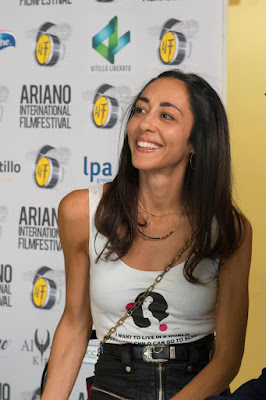Manuela Filomena was born in a small town in Irpinia called Ariano Irpino, located in the region of Campania. Her bringing up contributed to her choice of professions. “Like most Italian families, Sunday has always been a holiday to share with grandparents, aunts and uncles. Perhaps hearing their stories, sharing the work week, and exchanging ideas unknowingly fed my imagination and pleasure in storytelling,” she told me in a recent interview.
That pursuit led her down a long and varied path of international education, which began in England at Loughborough University where she studied art and design. During those years, she took film classes and discovered that editing was the part of the process she enjoyed most. She also developed an interest in writing. Her final project was a short film on environmental issues called “ A prayer for Earth,” which was shown at the university.
While pursuing an M.A. in film and television at the University of Suor Orsola Benincasa in Naples, Fiolmena reached an academic and professional turning point. She was mentored in theoretical and practical filmmaking, which gave her the chance to hone her skills in shooting, editing and post-production while deepening her understanding of the creative process of storytelling.
“My final project, a short film “Goodbye Agnes,” was supervised by the Italian documentary film director Gianfranco Pannone who taught me to see the innate cinematic elements of daily life,” she explains. The film premiered at the 2018 Med Film Festival in Rome. It was awarded Best Editing at the Las Vegas International Film Festival and received the Award of Commendation at the Canada Short Film Festival.
The enchanting 13-minute film follows Enzo, a young man who does something special for Agnes, a young pharmacy worker for whom he is developing feelings. This act of kindness requires a bit of mischief, which, in turn, gets him into trouble with the authorities. But his benign intent and sincerity not only move Agnes, they inspire the investigator assigned to his case.
 |
| A Scene from “Goodbye Agnes” |
Filomena is currently a Ph.D. candidate in comparative studies at Florida Atlantic University (FAU). During her first semester, she organized the second edition of the Italian American Film Festival held annually as a supplement to an Italian course taught by Dr. Ilaria Serra. “The theme of identity was an element that united the three films of this edition,” Filomena recalled. “During the course Italian America: Translating Identities, I studied the phenomenon of Italian immigration to the United States between 1880 and 1920, which led to the consequent creation of an Italian-American identity.”
Filomena finds her Ph.D candidacy a challenging and stimulating path. “Studying for me has always been a sort of therapy. The possibility of bringing stories to the big screen is not only a desire but also a way to express my point of view, how I see the world, how I see myself in others.” she said. She wants to dedicate her research to examining the intergenerational, female centered conflicts, giving space and voice to otherwise marginalized debates about women's issues. “I would like to investigate the similarities between the individuals (mainly women) across cultures but also aspirations and dilemmas, showing women not as isolated individuals but as socially located within the wider family and community."
Several of Filomena’s projects are available on her Vimeo channel, including her short film, “Goodbye Agnes.” Go to https://www.fau.edu/artsandletters/llcl/italian/italian-film-festival/ to check out FAU’s Italian American Film Festival.
-Written by Jeannine Guilyard for the September 2021 issue of Fra Noi Magazine. Click here to subscribe.

Comments
Post a Comment